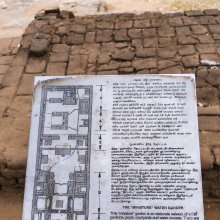Konda, Kondā, Komda: 8 definitions
Introduction:
Konda means something in Buddhism, Pali, the history of ancient India, Marathi, Jainism, Prakrit, biology. If you want to know the exact meaning, history, etymology or English translation of this term then check out the descriptions on this page. Add your comment or reference to a book if you want to contribute to this summary article.
Images (photo gallery)
(+9 more images available)
In Buddhism
Theravada (major branch of Buddhism)
Source: Pali Kanon: Pali Proper NamesSee Gonda.
Theravāda is a major branch of Buddhism having the the Pali canon (tipitaka) as their canonical literature, which includes the vinaya-pitaka (monastic rules), the sutta-pitaka (Buddhist sermons) and the abhidhamma-pitaka (philosophy and psychology).
India history and geography
Source: Project Gutenberg: Castes and Tribes of Southern India, Volume 11) Konda (“mountain”) is one of the many exogamous septs (division) among the Telugu section of the Devangas (a caste of weavers). The Devangas, speaking Telugu or Canarese, are found all over the Madras Presidency. Devanga is composed of Deva and angam, “limb of god”.
2) Konda (“mountain”) refers to one of the exogamous septs (divisions) among the Medaras: workers in bamboo in the Telugu, Canarese, Oriya and Tamil countries. The Medara people believe that they came from Mahendrachala mountain, the mountain of Indra. They are also known as the Meda, Medarlu or Medarakaran.

The history of India traces the identification of countries, villages, towns and other regions of India, as well as mythology, zoology, royal dynasties, rulers, tribes, local festivities and traditions and regional languages. Ancient India enjoyed religious freedom and encourages the path of Dharma, a concept common to Buddhism, Hinduism, and Jainism.
Biology (plants and animals)
Source: Wisdom Library: Local Names of Plants and DrugsKonda in the Telugu language is the name of a plant identified with Thysanolaena latifolia from the Poaceae (Grass) family having the following synonyms: Thysanolaena maxima, Agrostis maxima, Melica latifolia, Thysanolaena agrostis. For the possible medicinal usage of konda, you can check this page for potential sources and references, although be aware that any some or none of the side-effects may not be mentioned here, wether they be harmful or beneficial to health.
Source: Google Books: CRC World Dictionary (Regional names)1) Konda in India is the name of a plant defined with Aerva lanata in various botanical sources. This page contains potential references in Ayurveda, modern medicine, and other folk traditions or local practices It has the synonym Illecebrum lanatum Hort. Par. ex Moq. (among others).
2) Konda is also identified with Caryota urens It has the synonym Caryota urens Blanco (etc.).
3) Konda is also identified with Sorghum bicolor It has the synonym Holcus sudanensis (Piper) L.H. Bailey (etc.).
4) Konda in Philippines is also identified with Amorphophallus paeoniifolius It has the synonym Kunda verrucosa Raf., nom. illeg. (etc.).
Example references for further research on medicinal uses or toxicity (see latin names for full list):
· Prodr. (DC.) (1849)
· Prodromus stirpium in horto ad Chapel Allerton vigentium. (1796)
· Flora de Filipinas (1837)
· Taxon (1983)
· Taxon (2001)
· Species Plantarum (1753)
If you are looking for specific details regarding Konda, for example side effects, diet and recipes, extract dosage, health benefits, chemical composition, pregnancy safety, have a look at these references.

This sections includes definitions from the five kingdoms of living things: Animals, Plants, Fungi, Protists and Monera. It will include both the official binomial nomenclature (scientific names usually in Latin) as well as regional spellings and variants.
Languages of India and abroad
Marathi-English dictionary
Source: DDSA: The Molesworth Marathi and English Dictionarykōṇḍa (कोंड).—m C A circular hedge or field-fence. 2 A circle described around a person under adjuration. 3 The circle at marbles. 4 A circular hamlet; a division of a maujā or village, composed generally of the huts of one caste. 5 Grounds under one occupancy or tenancy. 6 f R A deep part of a river. 7 f (Or kōṇḍī q. v.) A confined place gen.; a lock-up house &c.
--- OR ---
kōṇḍā (कोंडा).—m Bran, husk of corn gen. 2 fig. Miliary scab, scurf. 3 fig. Rash, any efflorescence on the body. 4 A small kind of bamboo. 5 Commonly kōṃyaṇḍā. kōṇḍyācā māṇḍā karaṇēṃ To make, by culinary skill, a savory dish out of coarse materials.
--- OR ---
kōnda (कोंद).—f Sesamum-seed fried, pounded, sugared, and spiced.
Source: DDSA: The Aryabhusan school dictionary, Marathi-Englishkōṇḍa (कोंड).—f A deep part of a river. m A circu- lar hedge or field fence.
--- OR ---
kōṇḍā (कोंडा).—m Bran, husk of corn gen. Fig. Rash, any efflorescence on the body. kōṇḍyācā māṇḍā karaṇēṃ To make, by culina- ry skill, a savory dish out of coarse materials.
Marathi is an Indo-European language having over 70 million native speakers people in (predominantly) Maharashtra India. Marathi, like many other Indo-Aryan languages, evolved from early forms of Prakrit, which itself is a subset of Sanskrit, one of the most ancient languages of the world.
Prakrit-English dictionary
Source: DDSA: Paia-sadda-mahannavo; a comprehensive Prakrit Hindi dictionaryKoṃḍa (कोंड) in the Prakrit language is related to the Sanskrit words: Kauṇḍa, Gauḍa.
Prakrit is an ancient language closely associated with both Pali and Sanskrit. Jain literature is often composed in this language or sub-dialects, such as the Agamas and their commentaries which are written in Ardhamagadhi and Maharashtri Prakrit. The earliest extant texts can be dated to as early as the 4th century BCE although core portions might be older.
Kannada-English dictionary
Source: Alar: Kannada-English corpusKoṃḍa (ಕೊಂಡ):—[noun] a natural raised part of the earth’s surface, often rounded; a hill or hillock.
--- OR ---
Koṃḍa (ಕೊಂಡ):—
1) [noun] a round hole dug in the ground for receiving and preserving water.
2) [noun] a small round or square pin in the ground for the sacrificial fire.
3) [noun] a pool, well, esp. one consecrated to a deity or holy purpose.
4) [noun] an earthen pot.
--- OR ---
Koṃḍa (ಕೊಂಡ):—[noun] a Dravidian language akin to Kuī spoken in some parts of Orissa in eastern India.
Kannada is a Dravidian language (as opposed to the Indo-European language family) mainly spoken in the southwestern region of India.
See also (Relevant definitions)
Starts with (+300): Komdabamdi, Komdadisu, Komdadu, Komdaduhana, Komdagori, Komdaguri, Komdahabba, Komdakoti, Komdalaga, Komdalu, Komdamalle, Komdamama, Komdamavu, Komdamgi, Komdamusu, Komdamusudi, Komdamusuku, Komdamusuva, Komdamusuvu, Komdasu.
Ends with (+25): Aggikomda, Anumakonda, Balrajkonda, Bircakonda, Chakonda, Darakonda, Donikomda, Gangaikonda, Golkonda, Govarakonda, Jannakomda, Kaato-konda, Kakonda, Kalanakonda, Kanakonda, Kankonda, Kannida konda, Kapur konda, Kato-konda, Keokonda.
Full-text (+286): Kondabhatta, Konda-kalava, Pavasaca Konda, Ekalakota, Varakonda, Gauda, Kaunda, Kaunda bhatta, Tarkaratna, Vaiyakaranasiddhantadipika, Maheshamahotsava, Konda bhatta upadhyaya, Konda panookoo, Kerakonda, Konda Gorre, Kannida konda, Konda mayur, Konda panuku, Konda-thakali, Konda-kasimi.
Relevant text
Search found 18 books and stories containing Konda, Kondā, Komda, Kōṇḍa, Koṇḍa, Kōṇḍā, Koṇḍā, Kōnda, Koṃḍa; (plurals include: Kondas, Kondās, Komdas, Kōṇḍas, Koṇḍas, Kōṇḍās, Koṇḍās, Kōndas, Koṃḍas). You can also click to the full overview containing English textual excerpts. Below are direct links for the most relevant articles:
Apadana commentary (Atthakatha) (by U Lu Pe Win)
Commentary on Biography of the thera Kuṇḍadhāna < [Chapter 4 - Kuṇḍadhānavagga (section on Kuṇḍadhāna)]
The Four Noble Truths (by Ajahn Sumedho)
Part 1 - The Truth Of Impermanence < [Chapter 3 - The Third Noble Truth]
Early Chola Temples (by S. R. Balasubrahmanyam)
Chapter I - Parantaka I (Madirai-Konda Parakesari)
Temples in Tirukkalavur (Tirukkarugavur) < [Chapter II - Temples of Parantaka I’s Time]
Introduction < [Chapter I - Parantaka I (Madirai-Konda Parakesari)]
Later Chola Temples (by S. R. Balasubrahmanyam)
Temples in Perambakkam < [Chapter II - Temples of Kulottunga I’s Time]
Temples in Chilakalanerpu < [Chapter II - Temples of Kulottunga I’s Time]
Temples in Tirupperundurai < [Chapter XII - Temples of Kulottunga III’s Time]
The history of Andhra country (1000 AD - 1500 AD) (by Yashoda Devi)
Part 1 - Rajavibhala (A.D. 1400) < [Chapter XVIII - The Saluvas]
Part 14 - Later Kondapadumatis (A.D. 1252-1282) < [Chapter IV - The Kondapadumatis (A.D. 1100-1282)]
Introduction (Kota Dynasty) < [Chapter V - The Kotas (A.D. 1100-1270)]
Middle Chola Temples (by S. R. Balasubrahmanyam)
Temples in Chikkali < [Rajadhiraja I]
Temples in Emapperur < [Chapter II - Temples of Rajaraja I’s Time]
Temples in Tiruvanaikkaval (Jambukesvaram) < [Aditya I]
Related products






